The HIV Diagnostics Test Market is estimated to be valued at USD 4.86 Bn in 2025 and is expected to reach USD 9.12 Bn by 2032, growing at a compound annual growth rate (CAGR) of 9.4% from 2025 to 2032.
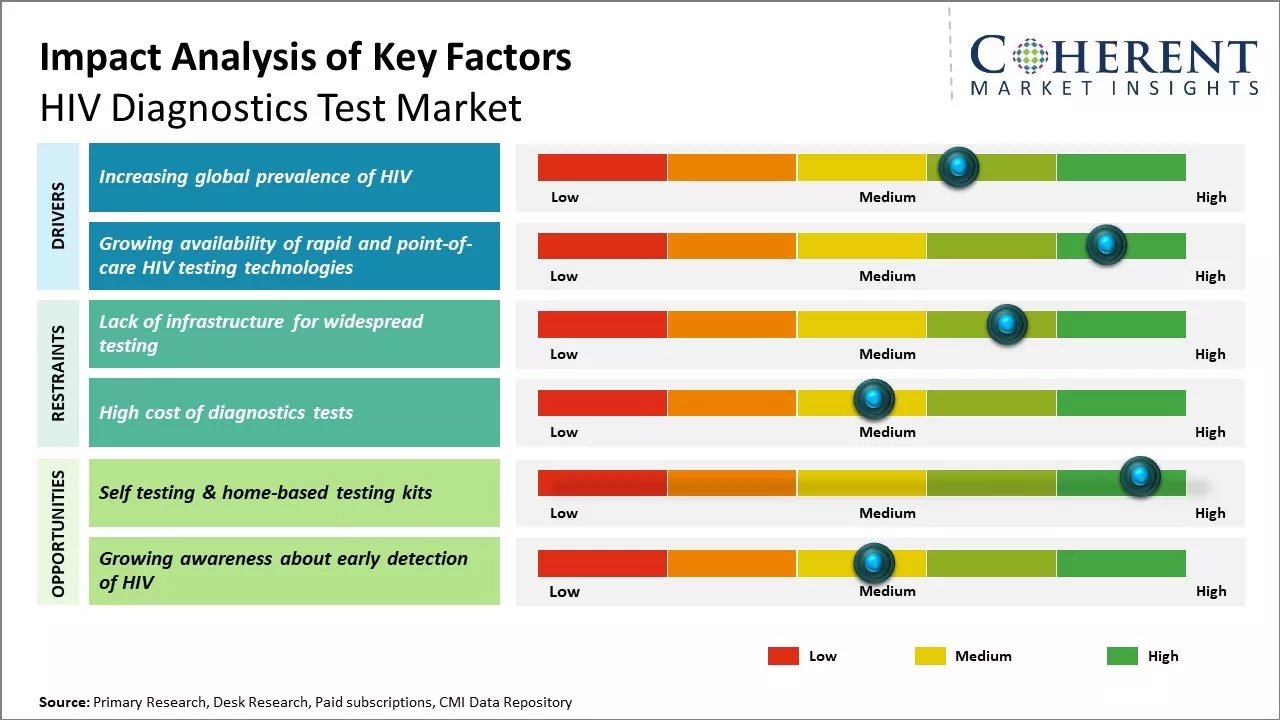
Discover market dynamics shaping the industry: Request sample copy
The market is expected to witness positive growth during the forecast period. Rapid expansion of healthcare investments and increasing awareness about HIV diagnosis are expected to boost market growth. In addition, rising initiatives by government and private organizations to spread awareness about HIV diagnosis and treatment is also expected to support the market growth during this period. However, costly diagnostics procedures and issues related to low accessibility in remote areas may hamper market growth.
Increasing global prevalence of HIV
The global prevalence of HIV has been steadily rising over the past few decades posing a significant risk to public health across the world. UNAIDS estimates that approximately 38 million people were living with HIV globally at the end of 2020, with new infections and AIDS-related deaths remaining unacceptably high in many regions. Sub-Saharan Africa in particular has borne the brunt of the epidemic where around 68% of all people living with HIV reside. While new infections and deaths from AIDS have declined significantly in some countries due to treatment scale-up, many nations still face severe challenges in diagnosing those unaware of their HIV status and linking them to effective care. According to WHO, in 2020, there were an estimated 1.5 million new HIV infections and 680,000 AIDS-related deaths worldwide.
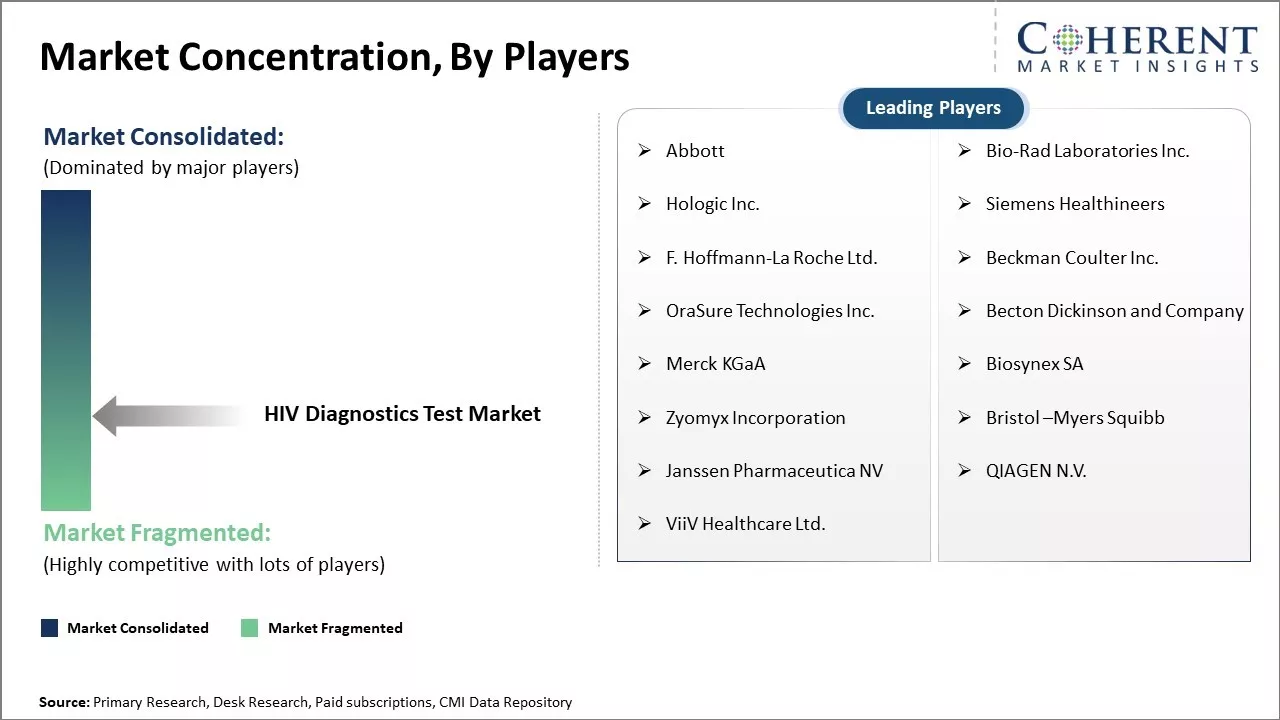
Get actionable strategies to beat competition: Request sample copy
Growing availability of rapid and point-of-care HIV testing technologiesWhile conventional HIV testing methods centered on laboratory-based immunoassays, recent years have witnessed significant advancements in rapid and point-of-care approaches. These innovative formats have played a transformative role in widening access to diagnostic services particularly in resource-constrained areas. Traditional testing involved sending blood samples to centralized laboratories for ELISA and Western blot analysis which could take days to provide results. This created barriers for timely diagnosis due to the need for multiple visits and loss to follow up. It was also challenging in remote communities with limited laboratory infrastructure.
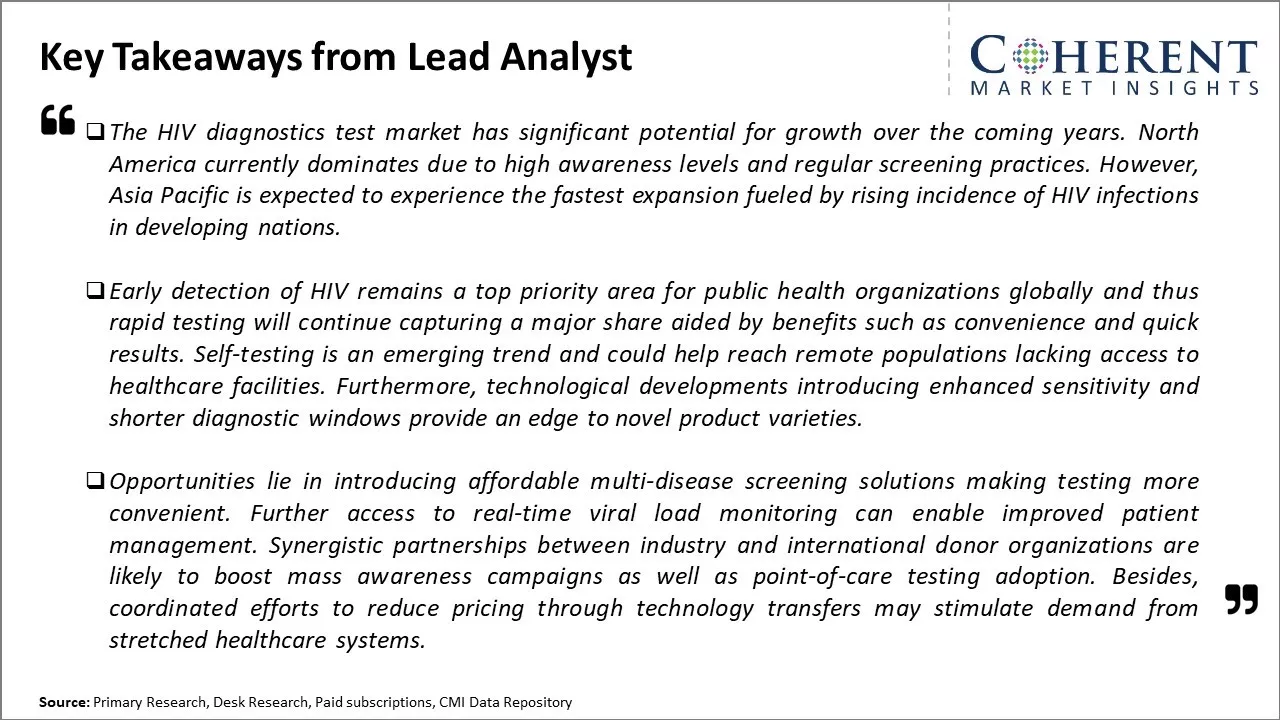
To learn more about this report, Request sample copy
Market Challenges: Lack of infrastructure for widespread testingThe HIV diagnostics test market faces several challenges. Many developing nations with high prevalence of HIV infection still lack sufficient medical facilities and infrastructure for widespread testing. This hampers accurate diagnosis and monitoring. Additionally, the social stigma associated with HIV poses barriers to testing, particularly in rural areas. Developing a reliable, affordable, and easy-to-use at-home testing kit remains a challenge due to technical limitations and regulatory hurdles.
Market Opportunities: Self testing & home-based testing kits
Self-testing and home-based HIV testing kits provide a private and confidential way for individuals to know their status without having to visit overburdened testing centers or clinics. This helps address a major barrier to testing which is the stigma still associated with HIV/AIDS. By making testing accessible in the privacy of one's home, more people especially from vulnerable groups will feel comfortable taking a test. With testing made easier, more frequent self-testing or self-screening at home would become the new norm. Campaigns by governments and NGOs promoting self-testing as the way forward are already raising awareness.
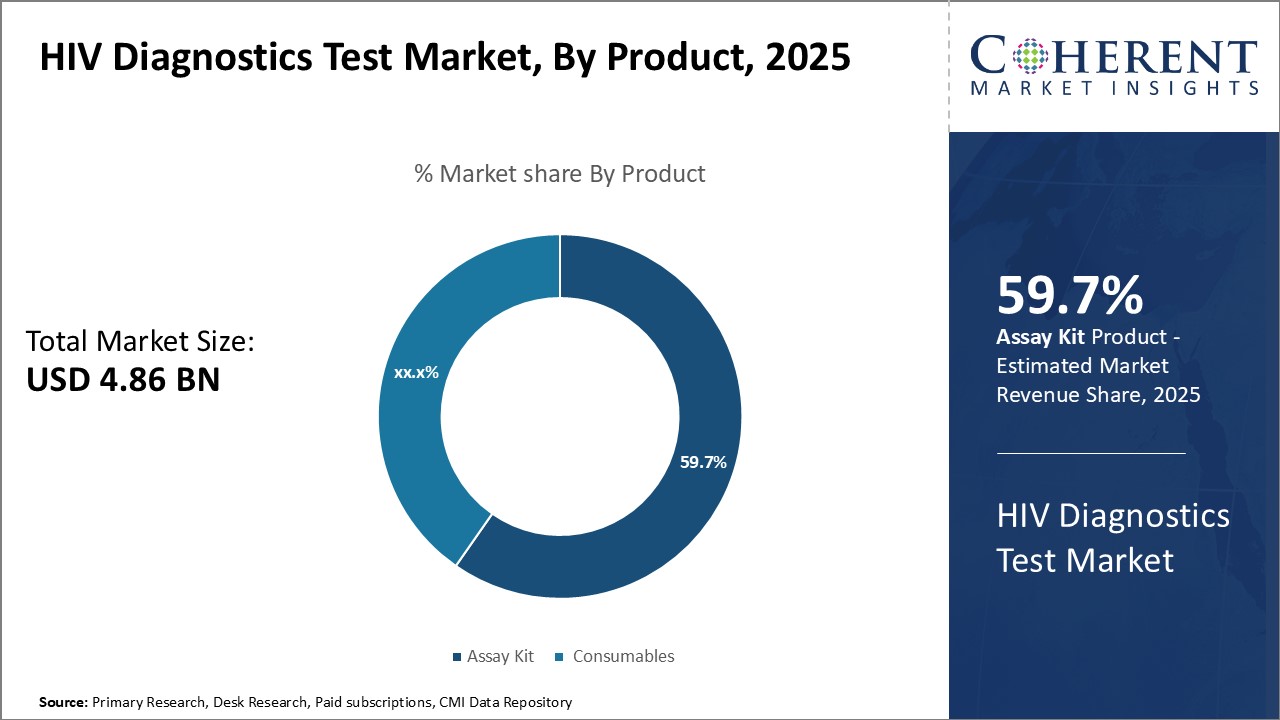
Discover high revenue pocket segments and roadmap to it: Request sample copy
Insights, By Product: Product Innovation Fuels Assay Kit DominanceThe product segment includes assay kit and consumables. Assay kit segment is estimated to hold 59.7% of the market share in 2025. Assay kits have seen significant improvements that have made testing simpler, more convenient, and accessible. Traditionally, HIV testing required specialized laboratory equipment and trained healthcare workers to perform. However, assay kit manufacturers have miniaturized tests so they can be performed with simplified equipment right in a doctor's office or even in home settings. This decentralized testing removes barriers to access and promotes more frequent screening. Assay kit makers also focus on test design to eliminate complex multi-step procedures that might dissuade patients. Newer generations of kits employ streamlined, user-friendly formats like simple prick tests that produce results within minutes with only a single drop of blood. Such innovations boost compliance and catch infections earlier.
Insights, By Test Type: Increased Standard of Care Drives Antibody Test Dominance
The test type segment includes antibody test, antigen/antibody tests, and nucleic acid test. Antibody test contributes the highest share of the HIV diagnostics test market and is estimated to hold 44.1% of the market share in 2025. Being the first developed test type, antibody detection set the baseline standard of care in HIV screening. It identifies the body’s immune response to infection by detecting antibodies produced against HIV. While newer forms like antigen/antibody combinations and nucleic acid methods provide additional insight, no alternative has proven more sensitive and cost-effective for broad population screening. Guidelines continue recommending antibody tests as the frontline screening methodology. Their wide availability and regulatory approval across all regions and settings, from remote clinics to large reference labs, cemented antibody tests role as the globally preferred first-line assay. Antibody tests also offer distinct benefits like stability at varying storage temperatures required for resource-limited areas.
Insights, By End User: Expanding Access Drives Diagnostic Laboratory's Development
The end user segment includes hospitals & clinics, diagnostic laboratories, homecare settings, and others. Diagnostic laboratories contribute the highest share of the HIV diagnostics test market and is estimated to hold 39.1% of the market share in 2025. Though hospitals initially managed most testing capacity, scaling screening require developing infrastructure beyond acute care settings. Diagnostic labs thus play a crucial role decentralizing testing closer to target populations. Their specialized expertise and regulatory compliance allow standardizing quality assessment across a network of customers. This provides health ministries and international programs an efficient, accountable partner for national screening cascades. By positioning multiple patient service centers, diagnostic labs facilitate walk-in access critical to identifying undiagnosed ‘key populations. Leveraging economies of scale in consumables procurement and coordination of supply chains keeps per-test costs low. This allows diagnostic networks offering subsidized or free panels to underinsured groups per public health priorities.
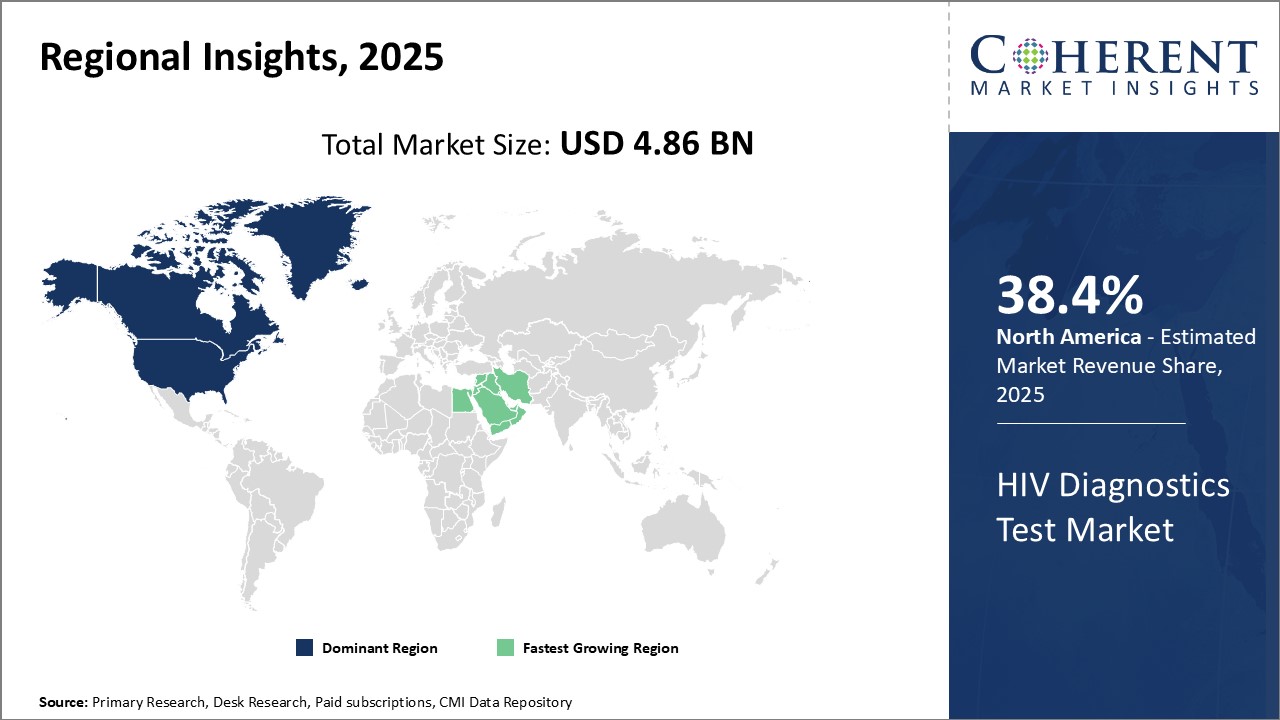
Need a Different Region or Segment? Customize now
North America has remained the dominant region in the global HIV diagnostics test market over the past decade and is estimated to hold 38.4% of the market share in 2025. Strong presence of leading international players, high awareness levels regarding sexually transmitted infections (STI) diagnosis and favorable reimbursement policies have augmented the demand for HIV diagnostic tests in the country. Moreover, heavy investments by both public and private players to develop advanced testing methods have ensured steady supplier access to the latest products.
The HIV diagnostics test market in the Middle East & Africa region is anticipated to develop at the highest CAGR over the forecasted period attributed to increasing healthcare investment by local and foreign organizations. The antibody test subsegment currently holds the largest share of the by test type segment in the HIV diagnostics test market in the Middle East & Africa region. This is driven primarily by the high adoption of fourth generation antibody tests in the region over the past 2 years. Fourth generation antibody tests are now widely used for HIV screening across major healthcare facilities in South Africa, Nigeria and Ethiopia due to their ability to detect both anti-HIV antibodies and the HIV p24 antigen. This allows for a much earlier detection of the infection compared to previous generations of antibody tests. Several observational studies conducted by UNAIDS and country-specific health ministries have found that the increased use of fourth generation antibody tests has helped reduce new HIV infections in the region by making it possible to identify positive cases much sooner.
HIV Diagnostics Test Market Report Coverage
| Report Coverage | Details | ||
|---|---|---|---|
| Base Year: | 2024 | Market Size in 2025: | USD 4.86 Bn |
| Historical Data for: | 2020 To 2024 | Forecast Period: | 2025 To 2032 |
| Forecast Period 2025 to 2032 CAGR: | 9.4% | 2032 Value Projection: | USD 9.12 Bn |
| Geographies covered: |
|
||
| Segments covered: |
|
||
| Companies covered: |
Abbott, Bio-Rad Laboratories Inc., Hologic Inc., Siemens Healthineers, F. Hoffmann-La Roche Ltd., Beckman Coulter Inc., OraSure Technologies Inc., Becton Dickinson and Company, Merck KGaA, Biosynex SA, Zyomyx Incorporation, Bristol –Myers Squibb, Janssen Pharmaceutica NV, QIAGEN N.V., and ViiV Healthcare Ltd. |
||
| Growth Drivers: |
|
||
| Restraints & Challenges: |
|
||
Uncover macros and micros vetted on 75+ parameters: Get instant access to report
Share
Share
About Author
Manisha Vibhute is a consultant with over 5 years of experience in market research and consulting. With a strong understanding of market dynamics, Manisha assists clients in developing effective market access strategies. She helps medical device companies navigate pricing, reimbursement, and regulatory pathways to ensure successful product launches.
Missing comfort of reading report in your local language? Find your preferred language :
Transform your Strategy with Exclusive Trending Reports :
Frequently Asked Questions
Joining thousands of companies around the world committed to making the Excellent Business Solutions.
View All Our Clients
US Reciprocal Tax Impact Analysis On HIV Diagnostics Test Market
Stay updated on tariff changes with expert insights and timely information